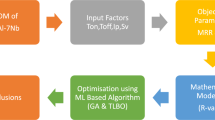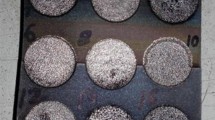Abstract
Wire-cut electrical discharge machining (WEDM) is a widely used non-contact machining process used to cut difficult-to-machine materials such as titanium, nickel and inconel alloys. WEDM is famous for producing components in diverse engineering applications, including automotive, marine, space, medical sectors with the highest accuracy and consistency. In this paper, experimental investigation on surface roughness (SR) of Ti6Al4V alloy employing WEDM process is presented using Taguchi L16 experimental plan by varying four process variables, viz., pulse on time (Ton), pulse off time (Toff), current (I) and wire speed (WS) at four different levels. The novelty of the present work is minimization of surface roughness (SR) in WEDM of Ti6Al4V alloy employing reusable wire technology during experimental work and optimizes the problem with modified teaching–learning-based optimization (M-TLBO) algorithm. A novel technique for fitness curve fitting is also illustrated to obtain global optima for minimization of SR. Results showed that SR decreased by 2.65% at optimal parameter setting Ton = 13 µs, Toff = 10 µs, I = 1 A and WS = 850 rpm and global optima is obtained as 3.749 µm. Pulse on time (44.06%) and current (28.69%) are recognized as the most dominant process variables affecting SR followed by pulse off time (15.80%) and wire speed (7.47%). Surface morphology study of machined Ti alloy using SEM images showed that smoother surface is obtained at lower settings of pulse on time and current. The proposed M-TLBO algorithm is found to be highly accurate and consistent during several runs conducted with mean fitness value and standard deviation recorded as 3.751 µm and 0.006417, respectively.











Similar content being viewed by others
References
Maher I, Sarhan AAD (2016) Proposing a new performance index to identify the effect of spark energy and pulse frequency simultaneously to achieve high machining performance in WEDM. Int J Adv Manuf Technol 91(1–4):433–443. https://doi.org/10.1007/s00170-016-9680-3
Maher I, Sarhan AAD, Hamdi M (2015) Review of improvements in wire electrode properties for longer working time and utilization in wire EDM machining. Int J Adv Manuf Technol 76(1–4):329–351. https://doi.org/10.1007/s00170-014-6243-3
Cheng X, Yang XH, Huang YM, Zheng GM, Li L (2014) Helical surface creation by wire electrical discharge machining for micro tools. Robot Comput Integr Manuf 30(3):287–294. https://doi.org/10.1016/j.rcim.2013.10.010
Gong YD, Sun Y, Wen XL, Zhou YG, Liu Y (2016) Experimental study on accuracy and surface quality of TC2 in LS-WEDM multiple cuts. J Braz Soc Mech Sci Eng 38(8):2421–2433. https://doi.org/10.1007/s40430-016-0513-y
Mahapatra SS, Patnaik A (2007) Optimization of wire electrical discharge machining (WEDM) process parameters using Taguchi method. Int J Adv Manuf Technol 34(9–10):911–925. https://doi.org/10.1007/s00170-006-0672-6
Ikram A, Mufti NA, Saleem MQ, Khan AR (2013) Parametric optimization for surface roughness, kerf and MRR in wire electrical discharge machining (WEDM) using Taguchi design of experiment. J Mech Sci Technol 27(7):2133–2141. https://doi.org/10.1007/s12206-013-0526-8
Manjaiah M, Narendranath S, Basavarajappa S (2014) A review on machining of titanium based alloys using EDM and WEDM. Rev Adv Mater Sci 36:89–111
Danial G, Abolfazl G, Izman S (2014) Multi-objective process optimization of wire electrical discharge machining based on response surface methodology. J Braz Soc Mech Sci Eng 36:301–313
Devarasiddappa D, Chandrasekaran M (2018) Evaluation of power consumption and MRR in WEDM of Ti–6Al–4V alloy and its simultaneous optimization for sustainable production. J Braz Soc Mech Sci Eng 40(5):400–417. https://doi.org/10.1007/s40430-018-1318-y
Hascalık A, Caydas U (2007) Electrical discharge machining of titanium alloy (Ti–6Al–4V). Appl Surf Sci 253(22):9007–9016. https://doi.org/10.1016/j.apsusc.2007.05.031
Kuriachen B, Somashekhar KP, Mathew J (2015) Multiresponse optimization of micro-wire electrical discharge machining process. Int J Adv Manuf Technol 76(1–4):91–104. https://doi.org/10.1007/s00170-014-6005-2
Rao RV, Savsani VJ, Vakharia DP (2011) Teaching–learning-based optimization: a novel method for constrained mechanical design optimization problems. Comput Aided Des 43:303–315. https://doi.org/10.1016/j.cad.2010.12.015
Rao RV, Kalyankar VD (2013) Parameter optimization of modern machining processes using teaching–learning-based optimization algorithm. Eng Appl Artif Intell 26(1):524–531. https://doi.org/10.1016/j.engappai.2012.06.007
Debroy A, Chakraborty S (2013) Non-conventional optimization techniques in optimizing non-traditional machining processes: a review. Manag Sci Lett 3:23–38. https://doi.org/10.5267/j.msl.2012.10.038
AltugM ErdemM, Ozay C (2015) Experimental investigation of kerf of Ti6Al4V exposed to different heat treatment processes in WEDM and optimization of parameters using genetic algorithm. Int J Adv Manuf Technol 78(9–12):1573–1583. https://doi.org/10.1007/s00170-014-6702-x
Kaur J, Chauhan SS, Singh P (2019) NSGLTLBOLE: a modified non-dominated sorting TLBO technique using group learning and learning experience of others for multi-objective test problems. In: Wang J, Reddy GRM, Prasad VK, Reddy VS (eds) Soft computing and signal processing: advances in intelligent systems and computing, 1st edn. Springer, Singapore, pp 243–251
Guo C, Lu J, Tian Z, Guo W, Darvishan A (2019) Optimization of critical parameters of PEM fuel cell using TLBO-DE based on Elman neural network. Energy Convers Manag 183:149–158. https://doi.org/10.1016/j.enconman.2018.12.088
Gucyetmez M, Cam E (2016) A new hybrid algorithm with genetic-teaching learning optimization (G-TLBO) technique for optimizing of power flow in wind-thermal power systems. Electr Eng 98(2):145–157. https://doi.org/10.1007/s00202-015-0357-y
Rao RV, Rai DP (2015) Optimization of advanced finishing processes using teaching-learning-based optimization algorithm. In: Jain VK (ed) Nano-finishing science and technology. Taylor and Francis, New York
Rao RV, Kalyankar VD (2014) Optimization of abrasive flow machining process. In: Jain VK (ed) Introduction to micromachining. Narosa Publishing House, New Delhi
Yuan J, Wang K, Yu T, Fang M (2008) Reliable multi-objective optimization of high-speed WEDM process based on Gaussian process regression. Int J Mach Tool Manuf 48(1):47–60. https://doi.org/10.1016/j.ijmachtools.2007.07.011
Li L, Li ZY, Wei XT, Cheng X (2014) Machining characteristics of Inconel 718 by sinking-EDM and Wire-EDM. Mater Manuf Process 30(8):968–973. https://doi.org/10.1080/10426914.2014.973579
Saha A, Mondal SC (2016) Experimental investigation and modeling of WEDM process for machining nanostructured hard facing material. J Braz Soc Mech Sci Eng 39(9):3439–3455. https://doi.org/10.1007/s40430-016-0608-5
Kuriachen B, Paul J, Mathew J (2012) Modeling of wire electrical discharge machining parameters using titanium alloy (Ti–6AL–4V). Int J Emerg Technol Adv Eng 2(4):377–381
Liao YS, Chuang TJ, Yu YP (2014) Study of machining parameters optimization for different materials in WEDM. Int J Adv Manuf Technol 70:2051–2058. https://doi.org/10.1007/s00170-013-5458-z
Ugrasen G, Ravindra HV, Prakash GVN, Keshavamu R (2014) Process optimization and estimation of machining performances using artificial neural network in wire EDM. Procedia Mater Sci 6:1752–1760. https://doi.org/10.1016/j.mspro.2014.07.205
Ram Prasad AVS, RamjiK DattaGL (2014) An experimental study on Wire EDM on Ti–6Al–4V alloy. Procedia Mater Sci 5:2567–2576. https://doi.org/10.1016/j.mspro.2014.07.517
Tonday HR and Tigga AM (2016) Analysis of effects of cutting parameters of wire electrical discharge machining on material removal rate and surface integrity. In: IOP conference series: materials science and engineering, vol 115-012013, pp 1–7. https://doi.org/10.1088/1757-899X/115/1/012013
Nourbakhsh F, Rajurkar KP, Malshe AP, Cao J (2013) Wire electro-discharge machining of titanium alloy. Procedia CIRP 5:13–18. https://doi.org/10.1016/j.procir.2013.01.003
Chalisgaonkar R, Kumar J (2015) Investigation of the machining parameters and integrity of the work and wire surfaces after finish cut WEDM of commercially pure titanium. J Braz Soc Mech Sci Eng 38(3):883–911. https://doi.org/10.1007/s40430-015-0335-3
Acknowledgements
The authors acknowledge the WEDM experimental facility available at the Department of Mechanical Engineering, BMSCE, Bengaluru, Karnataka (India) that was used to conduct the WEDM machining operations in this research work.
Author information
Authors and Affiliations
Corresponding author
Additional information
Technical Editor: Lincoln Cardoso Brandao.
Publisher's Note
Springer Nature remains neutral with regard to jurisdictional claims in published maps and institutional affiliations.
Rights and permissions
About this article
Cite this article
Devarasiddappa, D., Chandrasekaran, M. & Arunachalam, R. Experimental investigation and parametric optimization for minimizing surface roughness during WEDM of Ti6Al4V alloy using modified TLBO algorithm. J Braz. Soc. Mech. Sci. Eng. 42, 128 (2020). https://doi.org/10.1007/s40430-020-2224-7
Received:
Accepted:
Published:
DOI: https://doi.org/10.1007/s40430-020-2224-7




